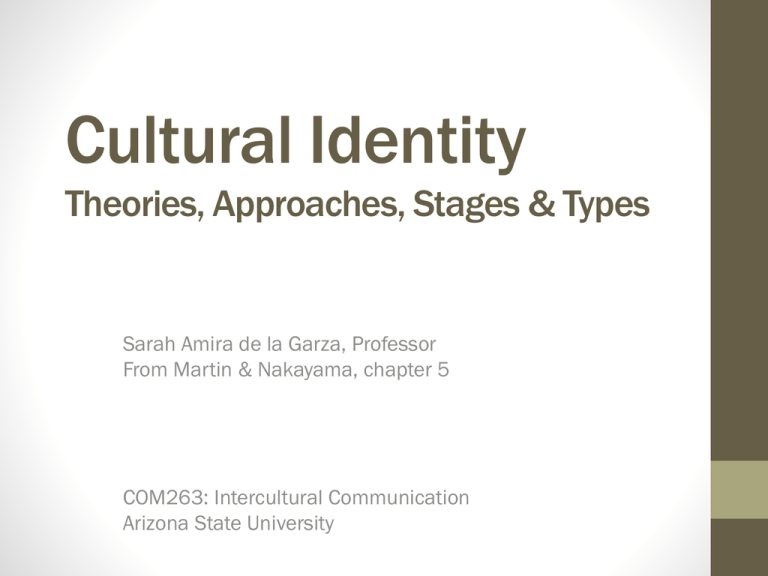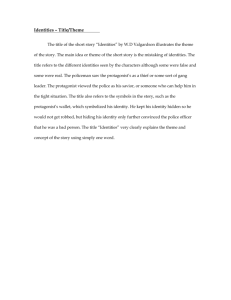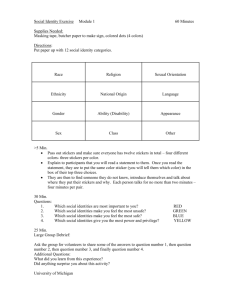Identities - WordPress.com
advertisement

Cultural Identity Theories, Approaches, Stages & Types Sarah Amira de la Garza, Professor From Martin & Nakayama, chapter 5 COM263: Intercultural Communication Arizona State University Identities & Culture Baby Boomer Yogi Woman I AM Heterosexual Spiritual Identity identity The concept of who we are. Character- istics of identity may be understood differently depending on the per- spectives that people take—for example, social science, interpretive, or critical perspectives. Two Theories of Identity Items for the Future impression management theory : The ways by which individuals attempt to control the impressions others have of them. identity negotiation theory: A theory that emphasizes the process of communicating one’s own desired identities while reinforcing or resisting others’ identities as the core of intercultural communication. Three Perspectives on Identity &Communication The First Step to Decluttering Social Science Identity created by self (by relating to groups) Emphasizes individualized, familial, and spiritual self (cross-cultural perspective) Interpretive Identity formed through communication with others Emphasizes avowal and ascribed dimensions Critical Identity shaped through social, historical forces Emphasizes contexts and resisting ascribed identity Social Science Approach Identity created by self (by relating to groups) • Emphasizes individualized, familial, and spiritual self (cross-cultural perspective) Three Dimensions of Identity (S.S.) (Roland, 1988) individualized identity The sense of self as independent and self-reliant. individualized identity The sense of self as independent and self-reliant. spiritual identity Iden- tification with feelings of connectedness to others and higher meanings in life. Interpretive Approach • Identity formed through communication with others • Emphasizes avowal and ascribed dimensions Interpretive Approach to Identiy (Hecht, et al) core symbols The fundamental beliefs that are shared by the members of a cultural group. Labels, a category of core symbols, are names or markers used to classify individual, social, or cultural groups. avowal The process by which an individual portrays himself or herself. ascription The process by which others attribute identities to an individual emphasizes that identities are negotiated, co-created, reinforced, and challenged though com- munication with others; they emerge when messages are exchanged between persons Critical Approach • Identity shaped through social, historical forces • Emphasizes contexts and resisting ascribed identity Critical Approaches to Identity Martin & Nakayama Contextual Identity Formation The driving force behind a critical approach is the attempt to understand identity formation within the contexts of history, economics, politics, and discourse. (Lacan) interpellation The communication process by which one is pulled into the social forces that place people into a specific identity. This gives rise to resistance. The Dynamic Nature of Identities The social forces that give rise to particular identities are never stable but are always changing. Therefore, the critical perspective insists on the dynamic nature of identities. What is Your Identity? • In what settings do you rely on a social science approach? • When is an interpretive approach useful? • What about the critical approach? MAJORITY, MINORITY, AND BIRACIAL IDENTITY DEVELOPMENT STAGES Like the developmental models that come out of learning theory, those who have studied race and culture have identified stages that are reflected in the identities that individuals develop regarding ethnicity. MINORITY IDENTITY DEVELOPMENTAL STAGES 1. Unexamined Identity • Lack of exploration of ethnicity • Acceptance of majority group values • Positive attitudes toward the majority group • Lack of interest in issues of ethnicity MINORITY IDENTITY DEVELOPMENTAL STAGES 2. Conformity • Internalization of dominant group norms; desire for assimilation into this group • Negative attitudes toward themselves and their groups until an experience causes them to question the dominant culture attitudes MINORITY IDENTITY DEVELOPMENTAL STAGES 3. Resistance & Separatism • Growing awareness that not all dominant values are beneficial to minorities • Often triggered by negative events • Blanket endorsement of one’s group’s values and attitudes • Rejection of dominant group values and norms MINORITY IDENTITY DEVELOPMENTAL STAGES 4. Integration • Ideal outcome of identity development— achieved identity • Strong sense of their own group identity and an appreciation for other cultural groups MAJORITY DEVELOPMENTAL STAGES 1. Integration • Lack of exploration of ethnicity • Acceptance of majority group values • Positive attitudes toward the majority group • Lack of interest in issues of ethnicity MAJORITY DEVELOPMENTAL STAGES 1. Integration • Lack of exploration of ethnicity • Acceptance of majority group values • Positive attitudes toward the majority group • Lack of interest in issues of ethnicity MAJORITY DEVELOPMENTAL STAGES 2. Acceptance • Internalization of a racist (race as the basis for determination of power and order)ideology (passive or active acceptance) • The key point is that individuals are not aware that they have been programmed to accept this worldview. MAJORITY DEVELOPMENTAL STAGES 3. Resistance • Moving from blaming minority members for their situations and beginning to blame their own dominant group MAJORITY DEVELOPMENTAL STAGES 4. Redefinition • Nonacceptance of society’s definition of white • Able to see positive aspects of being white • Becoming comfortable with being in dominant group MAJORITY DEVELOPMENTAL STAGES 5. Integration • Ideal outcome of identity development— achieved identity • Strong sense of their own group identity and an appreciation for other cultural groups BIRACIAL IDENTITY DEVELOPMENT STAGES 1. Possible Cycling Through 3 Stages • Awareness of differences and resulting dissonance • Awareness that they are different from other children • Sense that they don’t fit in anywhere BIRACIAL IDENTITY DEVELOPMENT STAGES 2. Struggle for Acceptance • May feel that they must choose between one race or the other. BIRACIAL IDENTITY DEVELOPMENT STAGES 3. Self Acceptance & Self Assertion • Ability to see the dual and dialectic nature of one’s identity • Abandons need to choose and transforms contradictions into tensions • Speaks for one’s individual identity as a function and/or product of one’s biracial Social & Cultural Identities •GENDER IDENTITY •SEXUAL IDENTITY •AGE IDENTITY •ETHNIC & RACIAL IDENTITIES GENDER IDENTITY The identification with the cultural notions of masculinity and femininity and what it means to be a man or a woman. SEXUAL IDENTITY One’s identification with various categories of sexuality. AGE IDENTITY The identification with the cultural conventions of how we should act, look, and behave according to our age. RACIAL IDENTITIES Identifying with a particular racial group. Although in the past racial groups were classified on the basis of biological characteristics, most scientists now recognize that race is constructed in fluid social and historical contexts. ETHNIC IDENTITY (1) A set of ideas about one’s own ethnic group mem- bership; (2) a sense of belonging to a particular group and knowing some- thing about the shared experience of the group. “HYPHENATED AMERICANS” U.S. Americans who identify not only with being U.S. citizens but also as being members of ethnic groups. Continued…





